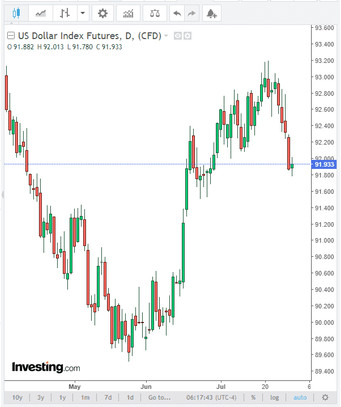As reported last Wednesday in the Energy Information Administration (EIA) of the US Department of Energy, oil reserves in the country last week fell by 4.089 million barrels (oil market analysts expected a decrease in oil reserves by 2.928 million barrels). On the eve, the American Petroleum Institute (API) reported a drop in reserves by 4.7 million barrels. Thus, stocks fell for the ninth of the last 10 weeks.
At the same time, the total oil production in the United States in the reporting period fell by 200,000 barrels to 11.2 million barrels, according to the EIA, which is also a positive factor for oil prices. The US Department of Energy also reported a drop in gasoline inventories by 2.3 million barrels, and distillate stocks - by 3.1 million barrels.
The positive weekly report of the Ministry of Energy on reserves and the results of the Fed meeting, which also ended on Wednesday, contributed to the further growth of oil prices.
As a result, WTI and Brent crude oil again rose into the zone above $ 70.00 per barrel. As of this writing, WTI crude oil futures are traded near $ 73.00 / bbl and are likely to end this week in positive territory.
The upward momentum in the price is also supported by the weakening of the dollar after the Fed meeting. As you know, last Wednesday the leaders of the American central bank signaled the need to further support the economy and continue stimulating measures.
The Fed revised its assessment of the economic situation with a slight increase in its official statement. "Against the backdrop of progress in vaccination of the population and strong government support measures, indicators of economic activity and employment continue to grow stronger. The sectors most affected by the pandemic have shown some improvement, but have not yet fully recovered", the central bank said.
The dollar has declined sharply since the Fed meeting, and the DXY dollar index will end this week, most likely with a decline of about 1%.

It is most likely that the overlapping factors (a sharp decline in US oil reserves and a weakening dollar) will help in the short term, WTI quotes to stay above $ 70.00 per barrel, economists say, despite fears of a new wave of the coronavirus pandemic and a slowdown in this regard economy and global oil demand.
However, in the longer term, it is probably still worth refraining from overly optimistic forecasts.
Firstly, it is connected with the expectations of the dollar strengthening. Despite the assurances of the Fed leaders in their commitment to maintaining the current parameters of the stimulus policy, rising inflation rates will still make them pay attention to this.
In June, US inflation exceeded the expectations of many economists for three consecutive months. Thus, the consumer price index (CPI) showed an increase of 5.4% compared to the same period last year, which is the highest since August 2008.
Investors are wondering how long it will take for central bank officials to reconsider their stance on inflation if price pressures do not ease up soon (Powell previously stated that the increased price pressures are temporary and may be due to supply chain disruptions and other factors related with a pandemic).
Concerns about the global spread of the coronavirus will also support demand for safe haven assets, including the dollar.
Secondly, following the results of the meeting that ended earlier this month, the OPEC+ members agreed on a phased increase in oil supplies by 400 thousand barrels per day from August to December. In addition to meeting the growing demand, the cartel aims to lower prices somewhat, considering them a little "overheated". The increase in production volumes in the countries of the OPEC+ coalition is a negative factor for oil prices.
Today, investors and oil market participants will await the publication (at 12:30) of data on income / expenses of Americans and the Personal Expenditure Price Index (PCE), as well as a report on active oil platforms from Baker Hughes (at 17:00 GMT). The Fed uses the base price index PCE (excluding food and energy prices) as the main indicator of inflation. Above expectations (+0.6% and +3.7% yoy) could push the US dollar higher.
At the same time, previous data from Baker Hughes reflected an increase in the number of rigs from 380 to 387 units, the fourth consecutive increase. It is obvious that the number of oil companies in the US is growing again, which is a negative factor for oil prices. Their next growth will also have a negative impact on oil quotes. However, it will be short-lived.
In general, at the moment and above the support levels 71.71, 71.37 (see “Technical analysis and trading recommendations”), long positions in WTI oil seem to be more preferable, the quotes of which returned to the levels of September-October 2018.





